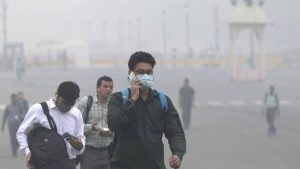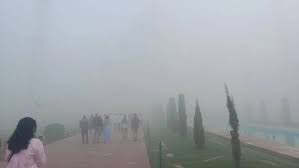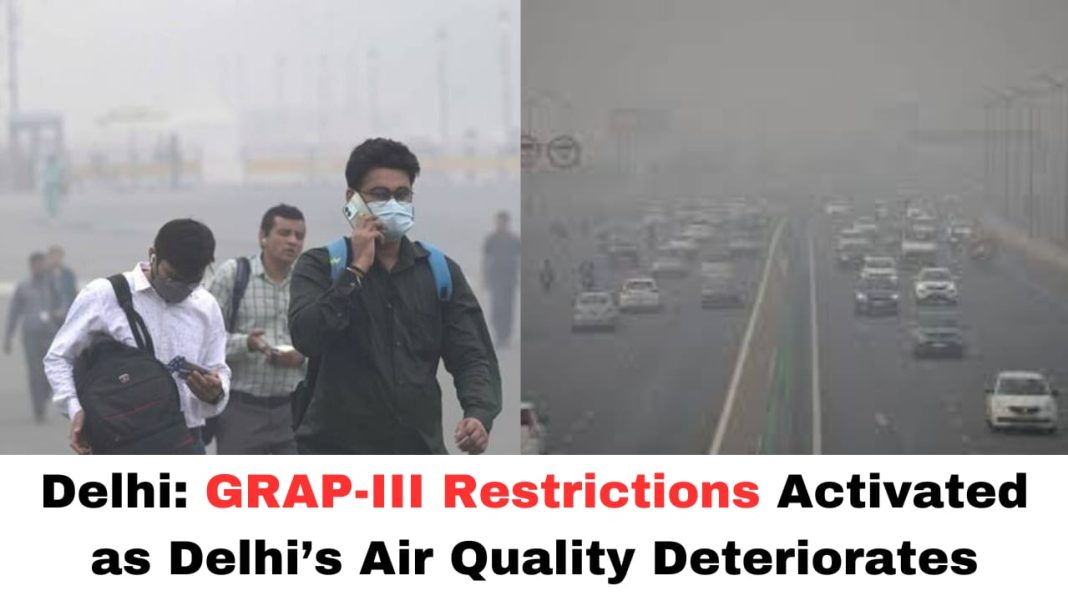Digital News Guru Delhi Desk:
As pollution levels continue to surge in northern India, authorities are intensifying measures to combat the hazardous air quality that is now heavily impacting daily life and some of the country’s iconic landmarks. Here’s an in-depth look at the situation, with a focus on the steps taken in Delhi and the visible consequences in neighboring cities.
Delhi Enforces GRAP-III Amid Alarming Pollution Levels
Delhi’s air quality has plunged into the “severe” category, crossing the Air Quality Index (AQI) threshold of 400, which signals extremely dangerous pollution conditions. In response, the Commission for Air Quality Management (CAQM) has activated Stage III of the Graded Response Action Plan (GRAP-III). This escalation comes as pollution from industrial emissions, vehicular traffic, and seasonal crop burning has blanketed the region, intensifying health risks for millions.
GRAP-III introduces several stringent controls aimed at curbing pollution. These include banning non-essential construction activities, restricting the use of diesel-powered vehicles that don’t comply with the latest emission standards, and discouraging private car usage. The authorities are also conducting inspections and deploying teams to monitor industrial emissions closely.

The Graded Response Action Plan (GRAP) is an emergency response mechanism designed to tackle severe air pollution in the Delhi-National Capital Region (NCR). Introduced by the Supreme Court in 2016 and enforced by the Commission for Air Quality Management (CAQM), GRAP lays out a set of escalating measures that are activated based on the severity of the Air Quality Index (AQI). The plan divides pollution control actions into four stages: Poor, Very Poor, Severe, and Severe+.
What is GRAP Stage III?
Stage III is implemented when the AQI falls into the “Severe” category, with readings between 401 and 450. Under this stage, stricter interventions are imposed to mitigate air pollution:
- Traffic and Vehicle Restrictions: Authorities may restrict the movement of certain vehicle types, such as banning BS-III petrol and BS-IV diesel cars. This aims to cut emissions from older and more polluting vehicles.
- Construction and Mining Bans: All construction and demolition activities, except for essential projects like national security or public service infrastructure, are halted. Similarly, mining operations are suspended to curb dust pollution.
- Enhanced Public Transport: To reduce traffic emissions, public transport services are intensified, with measures to promote carpooling and shared transportation. This also includes efforts to make public transit more efficient.
- Dust Suppression Measures: Authorities ensure roads are regularly cleaned using mechanized sweepers and water sprinklers. Dust suppression activities are intensified along high-traffic corridors and pollution hotspots.
- Stone Crusher and Hot Mix Plant Closures: To minimize industrial emissions, stone crushers and similar plants are temporarily closed.
- Educational and Business Adjustments: Local governments have the discretion to close schools or shift to online classes for younger children. They may also advise non-essential businesses to reduce activities.

The Importance of GRAP
The primary goal of GRAP is to protect public health and improve air quality through targeted and adaptive measures. By acting preemptively, it helps prevent air quality from deteriorating further, mitigating the adverse effects of pollution on health and the environment. GRAP emphasizes community awareness and enforcement, making it a critical framework in India’s broader strategy to combat air pollution.
These efforts highlight the urgency and the multi-faceted approach needed to address the annual pollution crisis, particularly during winter when stagnant air conditions exacerbate the problem. While GRAP has been instrumental in managing pollution episodes, experts call for long-term measures and structural reforms to achieve lasting air quality improvement.
Smog Envelops the Taj Mahal, Triggering Alarm
Agra, home to the Taj Mahal, is also grappling with the consequences of this environmental crisis. Heavy smog has shrouded the iconic marble mausoleum, significantly reducing visibility and heightening concerns over its preservation. The stunning structure, a UNESCO World Heritage site, is especially vulnerable to air pollution, which can corrode and discolor its pristine white surface. Experts and environmentalists have reiterated the need for more aggressive pollution control efforts to protect both the monument and public health in the region.

Calls for Stricter Pollution Management Intensify
The dire state of air quality across northern India has reignited calls for comprehensive and long-term solutions. In addition to immediate measures, environmental advocates are pushing for stricter regulations on industrial pollutants and more significant investments in green infrastructure. There is also mounting pressure to find sustainable alternatives to crop residue burning, a seasonal agricultural practice in neighboring states like Punjab and Haryana, which heavily contributes to the smog enveloping the region.
Moreover, the worsening situation has drawn attention to the need for collaboration between state and central governments to implement policies that prioritize clean energy and environmental conservation. Experts emphasize the urgency of addressing the root causes of air pollution rather than just mitigating its symptoms.
Broader Impact and Public Health Concerns
The health implications of the severe pollution crisis cannot be overstated. Prolonged exposure to such high pollution levels is linked to a range of respiratory and cardiovascular issues, with children and the elderly being particularly vulnerable. Medical professionals in Delhi and nearby areas have reported a surge in respiratory distress cases, and many residents are resorting to masks and air purifiers in an attempt to minimize their exposure.
As the region braces for more polluted days ahead, experts underscore that this crisis is a stark reminder of the global challenges posed by climate change and unchecked environmental degradation. While local measures like increased public transportation and construction bans provide short-term relief, a sustainable and effective strategy remains essential for long-term improvement.
The measures implemented under GRAP-III, along with the Delhi Metro’s initiatives, represent a collective effort to combat pollution, but there is widespread recognition that more proactive, innovative solutions are needed to ensure cleaner air for future generation.
You May Also Read: New on Disney+: The Stanford Prison Experiment and An Almost Christmas Story








